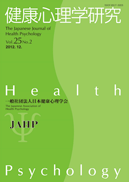Volume 16, Issue 2
Displaying 1-10 of 10 articles from this issue
- |<
- <
- 1
- >
- >|
-
2003 Volume 16 Issue 2 Pages 1-9
Published: December 25, 2003
Released on J-STAGE: January 07, 2015
Download PDF (612K) -
2003 Volume 16 Issue 2 Pages 10-19
Published: December 25, 2003
Released on J-STAGE: January 07, 2015
Download PDF (672K) -
Pain sensation during exposure to noxious stimuli: The effects of preparatory information and coping2003 Volume 16 Issue 2 Pages 20-29
Published: December 25, 2003
Released on J-STAGE: January 07, 2015
Download PDF (792K) -
2003 Volume 16 Issue 2 Pages 30-43
Published: December 25, 2003
Released on J-STAGE: January 07, 2015
Download PDF (1056K) -
2003 Volume 16 Issue 2 Pages 44-52
Published: December 25, 2003
Released on J-STAGE: January 07, 2015
Download PDF (605K) -
2003 Volume 16 Issue 2 Pages 53-59
Published: December 25, 2003
Released on J-STAGE: January 07, 2015
Download PDF (487K) -
2003 Volume 16 Issue 2 Pages 60-67
Published: December 25, 2003
Released on J-STAGE: January 07, 2015
Download PDF (583K) -
2003 Volume 16 Issue 2 Pages 68-76
Published: December 25, 2003
Released on J-STAGE: January 07, 2015
Download PDF (664K) -
2003 Volume 16 Issue 2 Pages 77-85
Published: December 25, 2003
Released on J-STAGE: January 07, 2015
Download PDF (648K)
-
2003 Volume 16 Issue 2 Pages 86-95
Published: December 25, 2003
Released on J-STAGE: January 07, 2015
Download PDF (784K)
- |<
- <
- 1
- >
- >|
